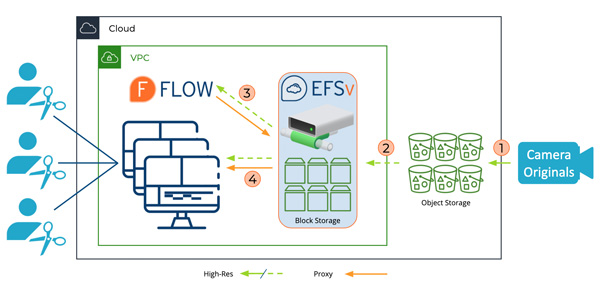EditShare EFSv Proxy Editing Eases Cloud Production Challenges

EditShare has further developed their EFSv storage and asset management system that virtualises collaborative editing in the cloud. The goal of this recent development was to change the economics of editing in the cloud while making dynamic and remote editing workflows more efficient and accessible to more facilities.
EFSv now optimises the use of both object and block storage located in the cloud to help save on the ongoing costs of cloud storage and workstations. In order to work on files in an NLE, they need to be identified and accessed through a drive and file system, which is what block storage has been designed for. But in the cloud, block storage is highly resilient, redundant across multiple servers and zones, and therefore is expensive.
With a simple architecture, simple API, resiliency and pay-as-you-go payment structure, cloud object storage is much more economical than block storage in the cloud, so much so that the cloud provider’s egress charges are largely offset by the low storage costs. But the fact that object storage has no file system with which to access and manipulate files is a major challenge, and it can also cause latency when used in workflows.
Developed to ease the complexity associated with proxy editing and conforming in the cloud, EFSv now supports direct proxy editing for Adobe, Avid, Blackmagic Design and Grass Valley editing packages. The costs saved through better management of cloud storage can be devoted to keeping production content and archives online and available at all times.

EditShare ESFv uses aspects of both systems, storing full resolution files in economical object storage and keeping lightweight proxy files in a small amount of standard block storage, nominated by the user, that is attached to EditShare’s Flow MAM. At the time clips are imported, the relationship between proxies and full res files is established. Editors can also use a workflow in which the proxies are downloaded.
Both sets of files are always available and accessible to the NLE application to help the editor manage the workflows for colour grading, visual effects and conforming. Audio is synced automatically, and at the end of the workflow, relinking proxies to the hi-res files for the conform is very quick.
It isn’t necessary for editors to work on virtual workstations to experience the speed improvements. The bandwidth needed to stream proxies to an on-premises workstation is roughly the same as what is needed to use cloud-based hardware.

For Adobe Premiere Pro, the new panel integrated into the UI that links Premiere to the Flow MAM system, automates the clip import process to make sure Premiere Pro understands that both versions exist. It also adds the ability to toggle back and forth between versions at any time, which causes a minimal amount of latency but may be needed to check the quality of the full resolution media.
EditShare says the costs of cloud production have been a barrier to wider adoption among media companies, who until now have mainly considered it as a back-up plan or short-term expansion to help with a specific situation or project.
If clients can limit their use of block storage to editing proxy files and maintain the high-resolution files on object storage, savings can be achieved. Focussing on new proxy editing functionality in EFSv and integrating cloud-based management that makes workflows simpler and reduces storage costs, the company believes they can support customers who want to shift entirely to the cloud. /www.editshare.com



